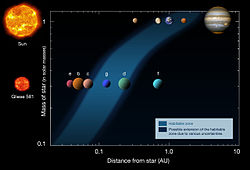GJ581orbits
SVG image of the Gliese 581 system orbits. The orbital parameters are taken from Mayor et al. (2009), arXiv:0906.2780v1 [astro-ph.EP] "Title: The HARPS search for southern extra-solar planets XVIII. An Earth-mass planet in the GJ 581 planetary system", table 2. The semimajor axes have been rederived using Kepler's Third Law and a central stellar mass of 0.31 solar masses, as the values in the table are given to 1 significant figure only for the innermost 3 planets. The description element in the SVG's source code gives further information.
Assumptions:
- It is assumed that the system is coplanar. This cannot be constrained by the radial velocity observations used to detect the planets in this system, but our solar system's planets are nearly coplanar, and both the systems of PSR B1257+12 (planets B and C) and Epsilon Eridani (planet b and the circumstellar disk) are coplanar, see Konacki and Wolszczan (2003), The Astrophysical Journal 591, L147–L150 "Masses and Orbital Inclinations of Planets in the PSR B1257+12 System" and Beust et al. (2006), The Astrophysical Journal 132, 2206–2218 "The Extrasolar Planet ɛ Eridani b: Orbit and Mass respectively, so this assumption is at least reasonable.
- The direction of rotation around the star is assumed to be the same for each planet. Again, this cannot be constrained by the current radial velocity observations, but is a reasonable assumption since this is true for the major planets in our own solar system, and is predicted by current theories of planet formation. Under these first two assumptions, the orientation of the orbits relative to each other is correct as depicted in this diagram, however their actual orientation in 3D space with respect to external reference points (e.g. the Sun, the galactic centre) is unknown, hence such directions are not indicated on the diagram.
- A further assumption is that the true masses of the planets are small compared to that of the star. If the masses were comparable to that of the star, the actual semimajor axis corresponding to the measured orbital period would be greater. This assumption is supported both by probability (the chance that we are observing a system which has sufficiently low inclination for this to be relevant is very low) and by dynamical stability arguments which indicate that the planets cannot have true masses much more than 1.6 times their minimum masses (Mayor et al., 2009). This effect can therefore safely be neglected.
Interpreting the diagram
The planetary orbits are drawn in orthographic projection, as viewed from directly above the plane of the system so that the orbital direction is anticlockwise. The dashed lines are drawn between the star and the periastron point of each planet, in order to depict the relative orientation of the orbits with respect to each other. The position of each planet in its orbit is calculated using the time of periastron in the table in the Mayor et al. (2009) paper, and are drawn at a time chosen to be close to the start of the Udry et al. (2007) radial velocity observations, which are available here. This time is chosen to minimise the effects of both uncertainties in the orbital parameters and potential orbital evolution of the system.
While the orbits are drawn to the correct scale, the star and the planets themselves are not shown to scale as they would be too small to see on the scale of this diagram. In addition, the true radii of the planets themselves are currently unknown as no direct observation of the planets has yet been made.Relevantní obrázky
Relevantní články
Gliese 581 gGliese 581 g je nepotvrzená exoplaneta, která obíhá okolo červeného trpaslíka Gliese 581. Nalézá se v souhvězdí Vah zhruba 20,5 světelných let od Země. Jedná se v pořadí o šestou objevenou planetu v této planetární soustavě. Planeta obíhá kolem své hvězdy v takové vzdálenosti, že její teplota umožňuje, aby se na jejím povrchu nebo blízko něho udržovala voda v kapalném stavu. Je asi 2,4× až 3× větší a asi 3,1× až 4,3× hmotnější než Země. Ze všech dříve objevených exoplanet je považována za planetu nejpodobnější Zemi, přestože už jsou objeveny nové s mnohem přívětivějšími podmínkami. .. pokračovat ve čtení
Gliese 581Gliese 581 (HO Librae) je hvězda v souhvězdí Vah, která je vzdálena od Země asi 22 světelných let a je červeným trpaslíkem spektrálního typu M3V. Má hmotnost třetiny našeho Slunce a je 89. nejbližší známou hvězdou. Pozorování naznačují, že hvězda má planetární systém, který obsahuje čtyři a nepotvrzené další dvě planety; Gliese 581 e, b, a c jsou potvrzené už delší dobu. V roce 2007 vědci potvrdili existenci planety d. Planety f a g jsou nepotvrzené. Gliese 581 byla předmětem značné pozornosti, byla u ní možnost existence první obyvatelné exoplanety. Nejprve byla pozornost věnována planetě c, poté planetám d a g. .. pokračovat ve čtení





